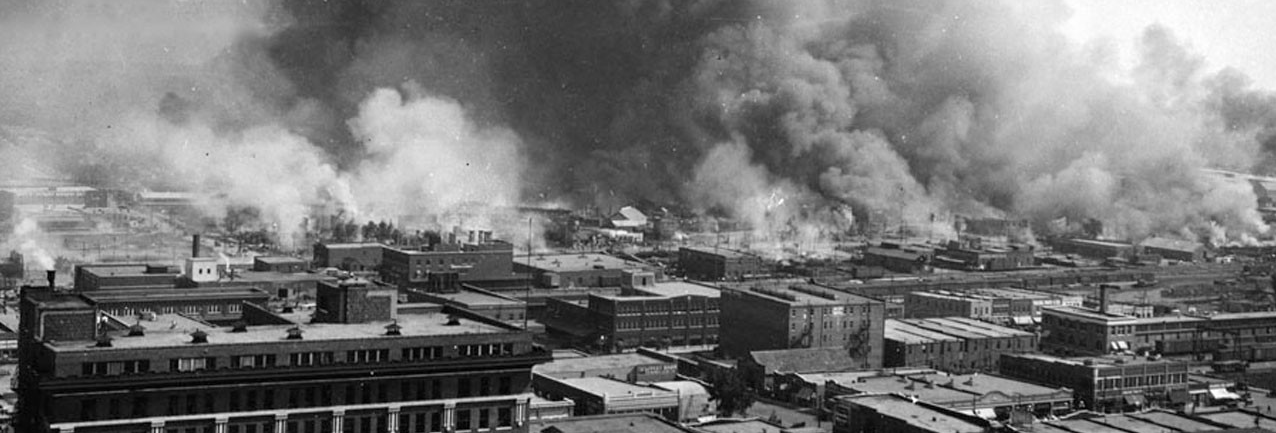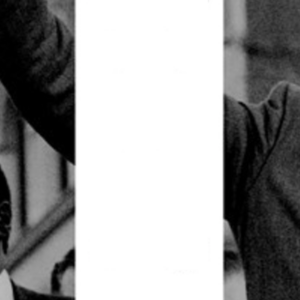The Tulsa Race Massacre decimated the neighborhood of Greenwood over the course of two days—May 31 and June 1, 1921—but such explosive carnage never stems from a single fuse. Racial turmoil in Tulsa and across the United States had been building for years before the attack.
Nineteen-nineteen should have been a year of celebration as World War I came to an end. But for black soldiers, the long shadow of violence was impossible to escape. In the months after the armistice, black units were forced to bury tens of thousands of corpses in the French countryside while white battalions enjoyed lavish victory parades. When black soldiers did make it home, many units were celebrated only grudgingly by the nation they had defended. In Tulsa, homecoming events for returning soldiers were segregated, and black veterans organized their own victory celebrations.
The mounting tension went far beyond rituals. After risking their lives and losing their innocence, black soldiers returning home bore no more patience for Jim Crow discrimination and violent white coercion. But standing up for themselves was dangerous. If a black veteran brushed a white man on the sidewalk and refused to apologize, white people might assault him in his military uniform.
Daniel Mack suffered such a fate after a white man stumbled into him on a sidewalk in Sylvester, Georgia. A scuffle ensued, but only Mack was arrested. Nine days later four white men removed him from his jail cell, beat him with clubs and ax handles, and left him for dead outside of town. Mack survived and fled the area.
The war marked a sea change in how black men viewed their own citizenship.Such actions were widely publicized in newspapers like the Chicago Defender, angering black people nationwide and laying the groundwork for a new, more militant breed of activism. White mobs had attacked black communities before World War I—in Wilmington, North Carolina, in 1898, Atlanta, Georgia, in 1906, and Springfield, Illinois, in 1908. But the war marked a sea change in how black men viewed their own citizenship.
They sincerely desired to apply the heroism they had mustered on the western front to protect their own people. And even among those who had not been off to war, calls for armed resistance against white incursions became common among black writers and activists. “For three centuries we have suffered and cowered,” W.E.B. Du Bois wrote in September 1919. “Today we raise the terrible weapon of Self-Defense.”
Over the course of 1919, riots in more than thirty U.S. cities, from New York City to Bisbee, Arizona, seized the country. In Chicago, the stoning of a black teenager sparked a week of mob violence between the races. In Washington, D.C., after a black man suspected of assaulting a white woman was released for lack of evidence, white instigators began beating black passersby on sidewalks and hauling them from streetcars. Attacks stretched from black neighborhoods to the shadow of the White House.
In Elaine, Arkansas, an estimated two hundred black people were killed by white vigilantes who falsely believed that black sharecroppers were staging a violent uprising. Overall, hundreds of people were killed, and thousands of homes and businesses were damaged or destroyed.
 St. Louis Globe-Democrat, July 3, 1917.
St. Louis Globe-Democrat, July 3, 1917.
There were broader contextual reasons that racial conflicts escalated in this period. For instance, the Great Migration was causing northern cities to swell with black workers competing with white laborers for jobs. But at their core, the conflicts reflected a raw, and overtly masculine, power struggle. Black men refused to accommodate racist terrorism and ambient subjugation any longer. White men took any display of force by blacks as a provocation and as justification for unchecked retaliatory violence, no matter how extreme.
The rampaging racists could not execute a reign of terror alone. White moderates accepted the violence even if they didn’t explicitly participate in it, often literally watching from the sidelines as blacks were attacked. The white press blamed blacks and outside agitators for the violence, offering the white establishment reassurances that their society was functioning just fine.
“All is quiet again,” an Atlanta Constitution journalist wrote after an April 1919 riot in rural Georgia. “The innocent will have nothing to fear.” Government officials blamed far-left socialists and union organizers for planting radical ideas in black people’s minds. Efforts to address the actual issue at hand—black people being murdered with hardly any intervention by the state—gained little traction at the federal level.
Dyer’s anti-lynching bill continued to languish in Congress, and while President Woodrow Wilson called mob law “a disgraceful evil,” he did not endorse Dyer’s bill or any other specific policy that might stop the killings. America had ostensibly entered the Great War to make the world safe for democracy, but the world of black Americans was being torn asunder.
Not only men were critiquing the rise of mob vigilantes. Greenwood resident Daisy Scott, the wife of boxer Jack Scott, was hired in 1920 as the Tulsa Star’s first regular cartoonist. Her sketches pilloried ineffective Republican politicians and the unwillingness of anyone in power to put a stop to the age of mob rule. In one Scott drawing, a pair of young black children were pursued by a mob that included one man with a billy club, one with a lynch rope, and a third clutching a whites only sign. “Shall these horrors await our future generations?” the Star asked in a caption.
 Daisy Scott, “The Future,” Tulsa Star, February 21, 1920.
Daisy Scott, “The Future,” Tulsa Star, February 21, 1920.
The end of summer brought more violence, as two men were lynched in Oklahoma in a single weekend during August 1920. In Oklahoma City, a black man named Claude Chandler had been arrested after being accused of killing two police officers during a shootout at his family’s bootlegging still. He was taken from his jail cell and hanged from a tree. Smitherman chastised the black men of Oklahoma City for not coming to Chandler’s defense before it was too late.
Every new atrocity—in Wagoner, Eufaula, and right at home in Tulsa—was strengthening their collective resolve to protect their own.What happened in Tulsa that weekend gave him even more reason to worry. A young white man, Roy Belton, was in the downtown jail, accused of murdering a white taxi driver. In the middle of the night, he was taken from his cell at the top of the courthouse, driven out of town by a caravan of cars, and hanged from a billboard. A mob of dozens ripped the clothes from Belton’s body as souvenirs, while police officers directed traffic. Tulsa County sheriff James Woolley called the mob attack under his watch “more beneficial than a death sentence pronounced by the courts,” while the Tulsa World called it a “righteous protest.”
Only Smitherman rang alarm bells about the collapse of the rule of law. “There is no crime, however atrocious, that justifies mob violence,” he wrote in a letter to Oklahoma governor James B. A. Robertson. He received anonymous death threats for speaking out.
In November 1920, as alarm rose that the racial violence of the Red Summer was subsuming the state, black leaders organized an Inter-Racial Conference seeking a path toward peace. Hundreds of such organizations had been mustered by southern white liberals, in conjunction with conservative blacks of the Booker T. Washington school of thought, in a response to the nationwide crisis.
Meeting in the chamber of the House of Representatives at the state capitol in Oklahoma City, hundreds gathered to discuss their demands for civil rights and how to defuse the intoxicating power of mob law. A.J. Smitherman looked on as Governor Robertson addressed the group. “A lyncher is a worse menace to a democratic form of government than a bolshevist who goes about waving a red flag and throwing bombs,” the governor said. His words were powerful, but he brought them to the wrong audience. As the Tulsa Star noted, “Fully fifty counties were represented in the conference by over five hundred well known colored men, but sad to relate, the white citizenry was largely conspicuous by its absence.”
All these arguments were bandied among the black upper class—in newspaper pages, courtrooms, and legislative chambers. But a parallel conversation was unfolding among Greenwood’s working class. Black people in Tulsa began refusing to get up from their seats when a white person stepped onto a crowded streetcar. They brushed past white people on the sidewalk without breaking stride. They challenged police directly, their guns at the ready, when they saw officers making arrests in Greenwood.
Most of the men who had been shipped off to France philosophized at the barbershop rather than in audience with the governor of Oklahoma. Robert Fairchild, a teenager in 1920s Greenwood, worked in shoeshine parlors and snuck into pool halls, where he often paid more attention to what adults were saying than he let on.
Looking back, Fairchild realized that every new atrocity—in Wagoner, Eufaula, and right at home in Tulsa—was strengthening their collective resolve to protect their own. “Associating with the hustlers and what have you, I often heard them say, ‘They better not ever try to lynch a Negro in Tulsa. ’Cause if they do, we gon’ be in the middle of it.’”
_____________________________

Excerpted from Built from the Fire: The Epic Story of Tulsa’s Greenwood District, America’s Black Wall Street by Victor Luckerson. Copyright © 2023. Available from Random House, a division of Penguin Random House, LLC.



